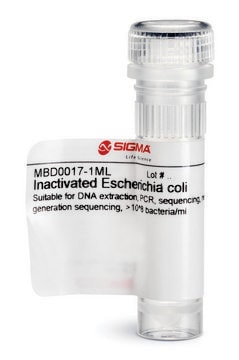推荐产品
一般說明
Escherichia coli is a non-pathogenic, facultative anaerobic flora present in the intestine of human. It belongs to the genus, Escherichia, which consists of motile gram-negative bacilli.
應用
Escherichia coli has been used:
- in the isolation of DNA from lyophilized cell
- in the preparation of crude cell lysate for developing scalable purification method for recombinant protein A
- as test proteome for comparative electrophoresis
儲存類別代碼
11 - Combustible Solids
水污染物質分類(WGK)
WGK 3
閃點(°F)
Not applicable
閃點(°C)
Not applicable
個人防護裝備
Eyeshields, Gloves, type N95 (US)
Diarrheagenic Escherichia coli
Nataro JP and Kaper JB
Clinical Microbiology Reviews, 11(1), 142-201 (1998)
Horizontal comparative fluorescence two-dimensional gel electrophoresis for improved spot coordinate detection
Hanneken M, et al.
Electrophoresis, 35(8), 1118-1121 (2014)
Accelerated recombinant protein purification process development: Automated, robotics-based integration of chromatographic purification and analysis
Londo T, et al.
Journal of Chromatography A, 798(1), 73-82 (1998)
Severe atopic dermatitis is associated with a high burden of environmental Staphylococcus aureus
Leung AD, et al.
Clinical and Experimental Allergy, 38(5), 789-793 (2008)
Marta Pacheco et al.
Mikrochimica acta, 189(5), 194-194 (2022-04-16)
Janus micromotors encapsulating transition metal dichalcogenides (TMDs) and modified with a rhodamine (RhO)-labeled affinity peptide (RhO-NFMESLPRLGMH) are used here for Salmonella enterica endotoxin detection. The OFF-ON strategy relies on the specific binding of the peptide with the TMDs to induce
我们的科学家团队拥有各种研究领域经验,包括生命科学、材料科学、化学合成、色谱、分析及许多其他领域.
联系技术服务部门







